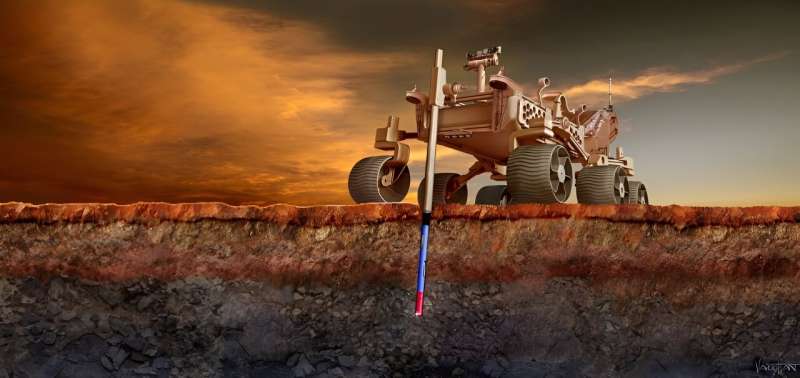Cylindrical autonomous drilling bot could reach buried Martian water
SO THAT'S WHERE THE MARTIANS GOT THEM

The south pole of Mars is a likely candidate for future exploration efforts there. It is also an area of interest for astrobiologists, as there is a decent chance that there might be signs of ancient water there and, therefore, signs of ancient life—if there was any on the red planet anyway.
But to access that ancient life, explorers would have to get to it, which means digging much further than has ever been dug on Mars before. Typical deep-bore drilling equipment is bulky, heavy, and difficult to set up on remote terrain like the Martian south pole. So a group of engineers from Planet Enterprises, a Space Technology Incubator based in Washington, developed a new deep bore drilling concept they call Borebots.
NASA's Institute for Advanced Concepts NIAC) support the Borebots concept back in 2021, and the engineers, led by Quinn Morley and Tom Bowen, produced a mammoth 96-page report of their efforts. That report details how Borebots are unique in the world of extraterrestrial drilling and how widely accepted the concept was in numerous other exploration contexts.
But the context it was designed for was to look for underground water in the Martian south pole. The engineers estimated they could collect interesting scientific data from a borehole measuring about 50 meters down.
Typically, a borehole that far down, even on Earth, would require some sort of tether back to the surface. Usually, that would include a cable or a rigid piping system that would provide power and control to the drill bit. That means a lot of material, most of it heavy, making it costly in space exploration.
So the team at Planet Enterprises came up with a solution—make autonomous bots that could do the drilling without being tethered to a base station. The bots themselves look like pieces of drilling tubing. Still, they are autonomous robots with a self-contained battery, drill bit, motor, and electronic system, all contained in a cylindrical housing that is 64mm in diameter by 1.1 meters long.
They could be deployed by a rover similar to the Perseverance rover already trundling around Mars. The rover could extend a deployment tube, which the bot would descend and start busily drilling away at the surface. Since it is remotely powered, its primary constraint would be its battery life, as using a drill bit to dig through regolith is power intensive. However, once it begins to run low on battery, it can simply engage a series of traction spikes on its side and climb back up the hole it had just dug.
Once the Borebot makes it back into the deployment tube and safely into the rover, it can be shunted aside to a cleaning and recharging station while another one takes its place. With this speed, the Borebot system could almost continuously dig down without the need for heavy support equipment—just a set of Borebots to keep hacking away at the rock.
The engineers thought of plenty of potential problems, including how to power a dead Borebot in the hole—they could be developed to power each other. And how could one make a branching bore if something is exciting in a particular area—by employing an articulated joint that would allow the next Borebot to proceed at a slight angle—and hopefully not mess up the climbing process of any other Borebots that decide to continue the central hole.
Plenty of interesting CAD designs and even some 3D-printed devices are described in the final report. It's not short on math either—describing calculations from the power electronics to the torque necessary for the drill head. They also mention there was some expressed interest from The Mars Society to flesh out the concept for resource extraction, as well as an idea to potentially utilize the idea on ocean worlds.
But for now, it's unclear if the project is undertaking the next step in development. While the paper details a clear plan to increase the Technology Readiness Level, it does not appear to have received further funding from NIAC, other any other funding source. However, the Planet Enterprises engineers haven't let that get them down—their TitanAir concept received a NIAC Phase I award in 2023. So they'll have plenty of time to keep working on their wildly innovative ideas.
More information: Borebots: Tetherless Deep Drilling into the Mars South Polar Layered Deposits: www.nasa.gov/sites/default/fil … _borebots_tagged.pdf
No comments:
Post a Comment